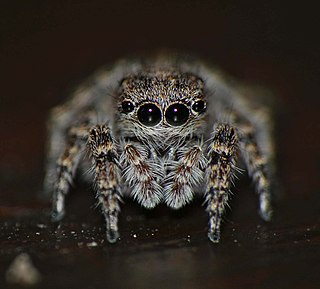
Afraflacilla is a genus of the spider family Salticidae. Most species are distributed in Eastern to Northern Africa and Australia, with two species found in Europe. This genus was for a time included in the genus Pseudicius, and the boundaries between both genera are disputed. In 2016 Jerzy Prószyński erected the genus Psenuc for some borderline species. The name Afraflacilla is combined from Africa, where most earlier described species were found, and FlacillaSimon, 1901, an obsolete salticid genus now called FlacillulaStrand, 1932. This genus name is in turn derived from Aelia Flaccilla, wife of Roman Emperor Theodosius I. Afraflacilla, Pseudicius, Festucula and Marchena are close relatives and form a monophyletic group.
Belippo is a genus of ant-mimicking African jumping spiders. The genus was first described by Eugène Louis Simon in 1910.
Cembalea is a genus of African jumping spiders that was first described by Wanda Wesołowska in 1993.

Evarcha is a genus of spiders in the family Salticidae with 85 species distributed across the world.

Icius is a genus of jumping spiders described by Eugène Simon in 1876, belonging to the Order Araneae, Family Salticidae.

Langelurillus is a spider genus of the family Salticidae. All the described species occur only in Africa.
Tanzania is a genus of jumping spiders that was first described by A. Ö. Koçak & M. Kemal in 2008. They are very small spiders, with body lengths ranging from 1.5 to 3 millimetres. Both sexes look alike, but the females are sometimes darker. It is related to the Euophrys and Talavera. Three new species discovered in Tanzania by Wesolowska and Russell-Smith in 2000, and given the genus name "Lilliput" are now included in the genus Tanzania.

Rhene is a spider genus of the family Salticidae.

Mexcala kabondo is a species of jumping spider in the genus Mexcala that lives in the Democratic Republic of the Congo, Malawi and Tanzania. The spider was first defined in 2009 by Wanda Wesołowska, one of over 500 that the arachnologist described during her career. It mimics ants and ant-like wasps, living alongside and preying upon them. The spider is medium-sized, with a brown to blackish carapace between 3.0 and 3.3 mm long and an abdomen between 4.0 and 5.3 mm long that is nearly black with a pattern of three black bands and four orange patches. It is typical of the genus. The internal structure of the female copulatory organs is the most distinguishing feature of the species. The male has not been described.
Evarcha vittula is a jumping spider species in the genus Evarcha that lives in South Africa.
Evarcha flagellaris is a jumping spider species in the genus Evarcha. It lives in Kenya and South Africa. The species was first described in 2011.

Langona hirsuta is a species of jumping spider in the genus Langona that lives in South Africa. It was first described in 2011 by Charles Haddad and Wanda Wesołowska. The spider is large with a carapace between 2 and 3.7 mm long and a abdomen between 1.9 and 4.4 mm long. The female is significantly larger than the male, particularly in the abdomen, which is also wider and a lighter brown. The male has very hairy pedipalps, after which it is named. It has the toothless chelicerae typical of the genus, and a single appendage, or apophysis, on the palpal tibia. The length of the apophysis helps to distinguish it from other spiders in the genus. It lives in semi-arid climates.

Icius pulchellus is a species of jumping spider in the genus Icius that lives in South Africa. It was first described in 2011 by Charles Haddad and Wanda Wesołowska. Only the female has been described. The spider is small, with a carapace measuring between 2.0 and 2.5 mm long and an abdomen that is between 2.0 and 2.4 mm in length. It has a sickle-shaped embolus. The spider is similar to the related Icius minimus, but can be distinguished by the pattern of the abdomen, which includes a brown stripe down the middle, and its short fat tibial apophysis.
Microbianor globosus is a jumping spider species of the genus Microbianor that lives in South Africa. The male was first described in 2011.
Afraflacilla karinae is a jumping spider species in the genus Afraflacilla that lives in South Africa. A published description of the female was first made in 2011, but the male has yet to be described. It is most closely related to Afraflacilla elegans.
Psenuc dependens is a jumping spider species in the genus Psenuc that lives in South Africa. The species was previously allocated to the genus Pseudicius. It was first described in 2011.
Psenuc solitarius is a jumping spider species in the genus Psenuc that lives in Namibia and South Africa. The species was previously allocated to the genus Pseudicius. The female was first described in 2011.
Belippo meridionalis is a jumping spider species in the genus Belippo that lives in South Africa. It was first identified in 2013.
Rhene facilis is a species of jumping spider in the genus Rhene. The spider, spotted in South Africa and Tanzania, is small with distinctive female and male forms. The female is light brown, with grey and red hints, and has a distinctive epigyne. The male is darker in colour, with an almost black carapace and a dark brown abdomen with a white patterns, and has a slightly curved embolus. The male was first described in 2000 and the female in 2013.
Rhene lingularis is a species of jumping spider in the genus Rhene that can be found in South Africa. The male was first identified in 2011. It is typical of the genus, and is small, dark brown and hairy. The spider is distinguished by its tongue-shaped embolus, from which its species name derives.







